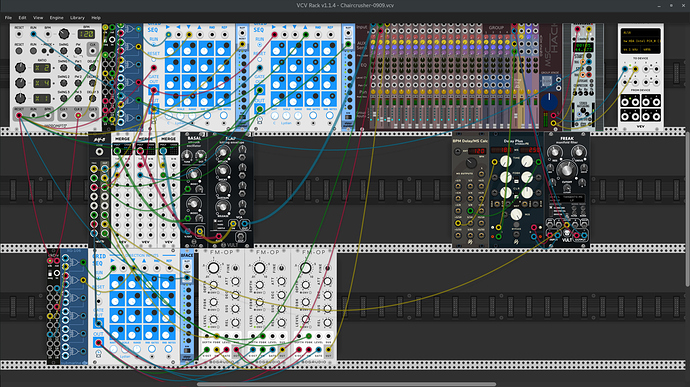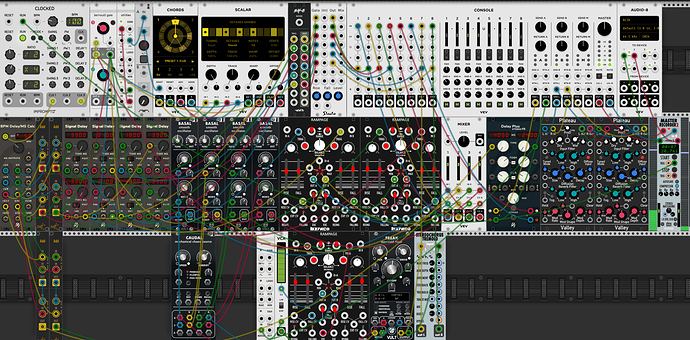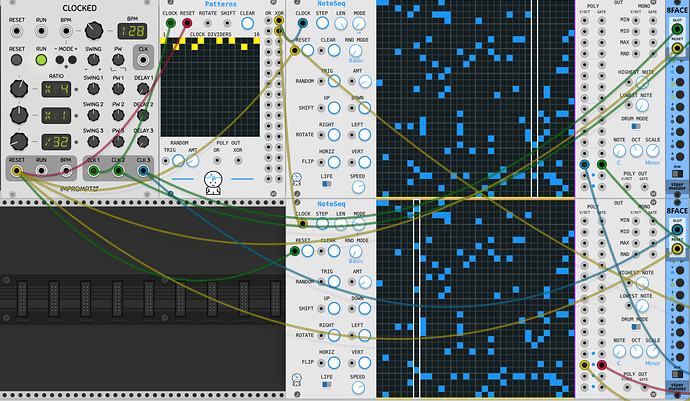I wonder what the overhead is of doing what I did (map an audio signal to a knob) versus having an FM input jack. The GUI seems to handle it, sort of, but the UI is only updated 30 times a second whereas modulations happen once per sample.
A test of using @stoermelder’ 8Face to save patch presets for @Skrylar’ Skylights Alan Turing Machine. And THEN using a second 8Face to save some presets of the first 8Face, for (potentially) 64 Alan sequences saved.
This ends up producing a long repeating sequence.
8FaceSkylightsFM.vcv (92.8 KB) http://cornwarning.com/chaircrusher/Chaircrusher-8FaceSkylights.mp3
Something that came together really quickly. You’ll notice it’s called “Resonator Techno” in the patch file. I recorded a bunch of live tweaking with this patch, then used WavAgent to split out the individual tracks from the 7 channel Wav file.
Bringing all the tracks to Ableton Live for arrangement and additional effects. Add my favorite jamming instrument AAS Lounge Lizard electric piano into chorus and delay.
There’s some rough & ready mastering (UAD2 Manley Massive Passive into UAD Fairchild 670) and then brought up to level with the Melda Loudness Analyzer.
http://cornwarning.com/chaircrusher/Chaircrusher-Messier66.mp3 resonatorTechno.vcv (126.1 KB)
The basic sequencing of this was done in VCVRack, but arranged and added to in Ableton Live.
The sampled sound that gets refracted through @synthi’s Confusing Sampler is the audio from a supercut of Jonathan Frakes on the show “Beyond Belief” saying things were fiction.
I’d upload the patch but it’s a dog’s breakfast.
New one. Involves a lot of post production but the sounds at the beginning are 2 Bogaudio FM Voices.
Drums are all in Rack, sequenced by a combination of a matrix sequencer and Frozen Wasteland Quad Euclidean sequencer.
Bass & pad tracked in Live – both NI Massive X.
This is kind of the end stage version of @jeremy wentworth’s Gridseq + Xor Clock tricks. Skipping/adding odd triggers makes for many useful surprises. The individual patterns don’t follow a standard 4/4 grid but the ear can pick up on how they repeat intuitively. I tried to add/change patterns on this intuitive grid, but since all three sequences aren’t the same length, they rub against each other differently over a longer time frame.
Being able to save and switch between Gridseq patches is indispensable. I was switching sequencer patterns live (and tweaking the pattern live).
No-reverb patches have great potential. Reverb makes everything sound good but blurry. Delays can give the sonic space some ‘air’ for the dry notes to live in a way similar to reverb, but with less smear and blur.
Since I currently don’t have an audio editor on this box, I used FFMPEG to convert to mp3 from 24-bit wav. This is just the sound coming off the mixer, no EQ, compression or editing. I think it sounds really nice as it is. Audio sample
Really cool! The audio sample sounds good. I like the delay. I have been using this xor trick with gridseq in my last several patches. I can’t add gridseq without it now.
Yeah it’s a great thing. What I like is it takes Gridseq – which, at it’s simplest you clock X with x4 pulse and Y with x1 pulse for a sequential sequence – and stretches it into a repeating sequence.
It suggests an auxiliary clock processor that would incorporate a similar trick. One clock in, several divider clocks out, each with several control knobs:
<skip Nth step, with full CCW=None> <skip Nth step, with full CCW=None> etc.
This would cover a LOT of interesting ground and be simpler than playing tricks with divider clocks and gates.
PS Keep this one quiet as it’s an unauthorized remix but I did the same kind of thing on this one, except I also used the new VCV Chord Module.
This one is a rough mix of something I want to take further. It is called “Milk Chocolate.”
Lobster – so named because apparently today is national Lobster day – uses pretty much all my tricks for ambient generative music at once, the only variation being using the VCV Chords module, run through Scalar to keep it aligned.
There’s a strange effect where notes change quickly even though the envelopes are super slow. I think it has to do with the root input to the Chord module changing and the note change propagating through the signal delays. I also screwed up a little as I run the CV/Gate for the first @modlfo Vult Basal through a delay when I could have just used it un-delayed. That accounts for the delay at the beginning where all you can hear is the chorused noise voice playing.
Lobster.vcv (53.9 KB)
This is an exercise in combining slow tempo, complicated trigger patterns from JW Patterns for @jeremy Wentworth’s GridSeq/
The mighty 8Face saves gridseq patterns and most of the ‘performance’ is switching between patterns and adding and removing notes.
A combination of signal delays and transpositions means a single sequence drives 3 voices. I also add outputs of the AS BPM together to get more varied delay times.
slowambient.vcv (110.3 KB)
http://cornwarning.com/chaircrusher/Chaircrusher-BuffaloSoldiers.mp3
Basal Canon came from an idea I had that might actually be a better fit to program in Ableton Live, to do a canon form, or in this case, a Round, since every voice (except the bass) is the same single sequence, delayed by a fixed offset value.
Currently I’m on a @modlfo Vult Basal kick, for a couple of reasons. It’s an oscillator where you have two controls to modify the harmonic richness. I use it to go from nearly sine to something else – whatever it is that it turns into with the two modifiers turned up. I use a combination of a ZZC sample & hold into a VCV polyphonic merge, so that each voice gets a different timbre with each trigger.
All the sequencer clocking runs through the @jeremy wentworth Patterns module to make the clocking a bit more complex. The bass notes are actually chosen by having an XOR-ed clock trigger a sample & hold to capture the current note coming from Gridseq and transpose it down.
The drums are a variation on my favorite trick where there is a regular pattern that runs through the track, but I use logic OR gates to combine 2 rows from the VCV Pulse matrix: One with a static pattern, and another that steps through the pattern randomly. This adds in extra hits as sequence runs to keep it from being 100% static. I use this trick over and over again and I think I’ve only scratched the surface on was sort of crazy stuff it can do.
And of course (of course) I use my favorite thing, which is to put effects in the feedback loop for delays. This means you have to fine-tune the feedback on the delays since you can get runaway feedback if you’re not careful. But it’s a cool enough idea to make a bit of tweaking worthwhile. basalcanon.vcv (111.3 KB)
There is a canon form where two voices play a melody, but the second voice plays backwards. This is known as a “crab canon.”
It occurred to me that GridSeq has clock inputs for forwards, backwards, up & down (in the grid) so it’s possible to have 2 voices play, but the second voice’s sequence is backwards/retrograde from the first. This patch does just that. Sort of. It plays the second sequence delayed 2 bars, and plays it backward.
But ALSO it steps through 8 different configurations of GridSeq. So at any time a sequence and its reverse is playing, but the sequences switch every so often. So it’s a set of crab canons that play one after another. reverseCanon.vcv (132.3 KB)
Here’s a sequencing idea I tried out:
- Duplicate the same sequencer 4 times
- The first sequencer is set to 16 steps. The second to 15, the third to 13, the 4th 11 steps.
- connect all sequencers to the same reset signal.
The result is that the sequences start out in sync, but they cycle against each other. It’s a repeating sequence but in this case, it will take 161513*11 steps to repeat!
To make the sequence even longer, I use 8Face preset arrays so there are 8 16-step sequences that get stepped through sequentially. So it will take 161513118 steps to repeat. Or maybe even more; the way the patch is implemented, the preset changes happen on 4 bar boundaries, but the sequences with odd numbers of steps will switch mid-pattern most of the time.
It wouldn’t be hard using this technique to come up with a repeating sequence that will take until the heat death of the universe to repeat. Hey @antonio.grazioli do you see that the 16-step sequencers are getting clipped on the right side so that the 16th step knobs and jack are only partially visible? This is on Linux but I bet the module has the same issue everywhere.
PrimeSequencer.vcv (303.6 KB)
Sequencer is not clipped on both my W7 and W10 computers
Love learning from your patching strategies! Keep these coming!
This is a refinement on the same basic idea: Make a crab canon by using the same @stoermelder 8Face presets to control 2 instances of @jeremy’s JW NoteSeq. The difference is that once I copy the 8Face instance, I change the mode to backwards, and overwrite each of the saved presets.
The result is - I think - a legitimate crab Canon, as it’s the same set of sequences played forward and backwards at the same time, and switched in sync. The two voices should be the same sequence of notes one played forward and the other played backwards.
http://cornwarning.com/chaircrusher/Chaircrusher-CrabCanon2.mp3 crabcanon2.vcv (219.4 KB)
I was thinking about the Crab Canon Part Deux, and spent a bit of time tweaking it.
- Instead of hitting the random button to generate 3 patterns, I actually wrote 3 patterns.
- I send the NoteSeqs a steady 16th note clock instead of the skippy clock you get from XORing several clock divisions together.
- Set the ‘preset advance’ clock to /8. This is from the Impromptu Clocked to the 8Face preset holders.
Now the NoteSeq patterns play through exactly once before advancing to the next pattern.
Time-saving realization: You can copy a preset from one module and paste it onto another module of the same type. GAME CHANGER.
crabcanon2.1.vcv (231.5 KB)
Work in progress. It combines results of two patches in Live (including the Crab Cannon), and I added some percussion and pad in Live.
It’s one of those cases where I want to layer in more stuff than will fit. There’s tracks from the VCVRack multitrack that I had to mute because they ended up being too much. Maybe they’ll turn up in another track
Sounding really good so far. Nice and clean, no mud. I can just barely recognize the Cannon, but it occasionally pokes through.







